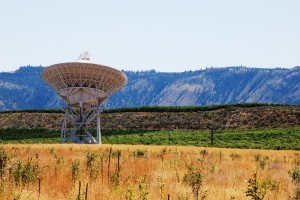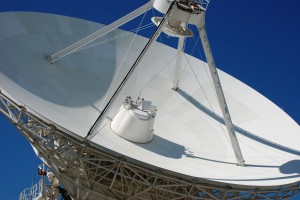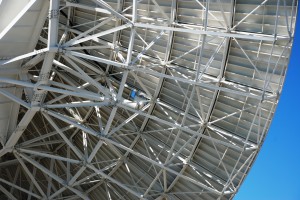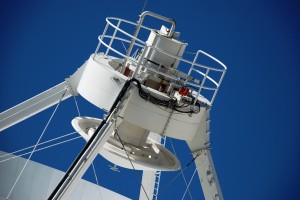We started our summer vacation with a trip to the Very Large Baseline Array (VLBA), or I should say, one of the ten radio telescopes that comprise the VLBA. The powers that be at the National Radio Astronomy Observatory (NRAO) saw fit to place one of the dishes near Brewster, Washington, an act which positioned it directly on the path between the Spokane airport and my parents’ house.
At the moment, the VLBA is the world’s largest dedicated telescope array with the sharpest resolution. The telescope spans 5,351 miles (8,611 km), with dishes located near Brewster; Owens Valley, CA; Pie Town, NM; Fort Davis, TX; Los Alamos, NM; North Liberty, IA; Hancock, NH; Mauna Kea, HI; Kitt Peak, AZ; and St. Croix, Virgin Islands. The ten telescopes—each with a reflecting dish, feed/antenna & receiver—are connected via transmission line and combine to form a massive interferometer with a spectacularly high resolution. All the dishes gather a radio signal from the same object at the same time. When the received signal from one telescope is superposed with the next, and so on, the ten single telescopes function as if they were one massive instrument with a baseline as large as the greatest distance between dishes.
Some telescope arrays, like the Very Large Array (VLA), can change the baseline length, and therefore the resolution of an image, by relocating individual telescopes along tracks. The ten telescopes of the VLBA are at fixed points; they rotate, but don’t move horizontally. However, they can be asked to work together with other radio telescopes (Arecibo, Effelsberg, NRAO’s Green Bank Telescope or the VLA) to perform as the High Sensitivity Array.
If you’d like to watch the Brewster telescope “in action,” NRAO provides a real-time feed of the instrument (refreshes every five minutes). They’ve also provided a fairly lucid explanation of radio astronomy and some kind of cool movies of black holes as observed by the VLBA. And, if you’re like me, and prefer to follow inanimate objects on twitter, you can follow the lives of the telescopes @TheNRAO. There are thirty-two more photos of the instrument on my flickr site, including several that can be strung together in a slide show to depict the slewing of the telescope .



